[English] 日本語
 Yorodumi
Yorodumi- EMDB-1157: ATPase-dependent cooperative binding of ORC and Cdc6 to origin DNA. -
+ Open data
Open data
- Basic information
Basic information
| Entry | Database: EMDB / ID: EMD-1157 | |||||||||
|---|---|---|---|---|---|---|---|---|---|---|
| Title | ATPase-dependent cooperative binding of ORC and Cdc6 to origin DNA. | |||||||||
 Map data Map data | 3D map of the yeast (Saccharomyces cerevisiae)DNA origin recognition complex (ORC) bound with initiation factor Cdc6p. | |||||||||
 Sample Sample |
| |||||||||
| Function / homology | Origin recognition complex, subunit 2 / nuclear origin of replication recognition complex / nuclear pre-replicative complex / AAA+ ATPase domain Function and homology information Function and homology information | |||||||||
| Biological species |  | |||||||||
| Method | single particle reconstruction / cryo EM / negative staining / Resolution: 20.0 Å | |||||||||
 Authors Authors | Speck C / Chen Z / Li H / Stillman B | |||||||||
 Citation Citation |  Journal: Nat Struct Mol Biol / Year: 2005 Journal: Nat Struct Mol Biol / Year: 2005Title: ATPase-dependent cooperative binding of ORC and Cdc6 to origin DNA. Authors: Christian Speck / Zhiqiang Chen / Huilin Li / Bruce Stillman /  Abstract: Binding of Cdc6 to the origin recognition complex (ORC) is a key step in the assembly of a pre-replication complex (pre-RC) at origins of DNA replication. ORC recognizes specific origin DNA sequences ...Binding of Cdc6 to the origin recognition complex (ORC) is a key step in the assembly of a pre-replication complex (pre-RC) at origins of DNA replication. ORC recognizes specific origin DNA sequences in an ATP-dependent manner. Here we demonstrate cooperative binding of Saccharomyces cerevisiae Cdc6 to ORC on DNA in an ATP-dependent manner, which induces a change in the pattern of origin binding that requires the Orc1 ATPase. The reaction is blocked by specific origin mutations that do not interfere with the interaction between ORC and DNA. Single-particle reconstruction of electron microscopic images shows that the ORC-Cdc6 complex forms a ring-shaped structure with dimensions similar to those of the ring-shaped MCM helicase. The ORC-Cdc6 structure is predicted to contain six AAA+ subunits, analogous to other ATP-dependent protein machines. We suggest that Cdc6 and origin DNA activate a molecular switch in ORC that contributes to pre-RC assembly. | |||||||||
| History |
|
- Structure visualization
Structure visualization
| Movie |
 Movie viewer Movie viewer |
|---|---|
| Structure viewer | EM map:  SurfView SurfView Molmil Molmil Jmol/JSmol Jmol/JSmol |
| Supplemental images |
- Downloads & links
Downloads & links
-EMDB archive
| Map data |  emd_1157.map.gz emd_1157.map.gz | 3.3 MB |  EMDB map data format EMDB map data format | |
|---|---|---|---|---|
| Header (meta data) |  emd-1157-v30.xml emd-1157-v30.xml emd-1157.xml emd-1157.xml | 17.2 KB 17.2 KB | Display Display |  EMDB header EMDB header |
| Images |  1157.gif 1157.gif | 33.4 KB | ||
| Archive directory |  http://ftp.pdbj.org/pub/emdb/structures/EMD-1157 http://ftp.pdbj.org/pub/emdb/structures/EMD-1157 ftp://ftp.pdbj.org/pub/emdb/structures/EMD-1157 ftp://ftp.pdbj.org/pub/emdb/structures/EMD-1157 | HTTPS FTP |
-Validation report
| Summary document |  emd_1157_validation.pdf.gz emd_1157_validation.pdf.gz | 189.5 KB | Display |  EMDB validaton report EMDB validaton report |
|---|---|---|---|---|
| Full document |  emd_1157_full_validation.pdf.gz emd_1157_full_validation.pdf.gz | 188.6 KB | Display | |
| Data in XML |  emd_1157_validation.xml.gz emd_1157_validation.xml.gz | 5.2 KB | Display | |
| Arichive directory |  https://ftp.pdbj.org/pub/emdb/validation_reports/EMD-1157 https://ftp.pdbj.org/pub/emdb/validation_reports/EMD-1157 ftp://ftp.pdbj.org/pub/emdb/validation_reports/EMD-1157 ftp://ftp.pdbj.org/pub/emdb/validation_reports/EMD-1157 | HTTPS FTP |
-Related structure data
- Links
Links
| EMDB pages |  EMDB (EBI/PDBe) / EMDB (EBI/PDBe) /  EMDataResource EMDataResource |
|---|
- Map
Map
| File |  Download / File: emd_1157.map.gz / Format: CCP4 / Size: 3.7 MB / Type: IMAGE STORED AS FLOATING POINT NUMBER (4 BYTES) Download / File: emd_1157.map.gz / Format: CCP4 / Size: 3.7 MB / Type: IMAGE STORED AS FLOATING POINT NUMBER (4 BYTES) | ||||||||||||||||||||||||||||||||||||||||||||||||||||||||||||||||||||
|---|---|---|---|---|---|---|---|---|---|---|---|---|---|---|---|---|---|---|---|---|---|---|---|---|---|---|---|---|---|---|---|---|---|---|---|---|---|---|---|---|---|---|---|---|---|---|---|---|---|---|---|---|---|---|---|---|---|---|---|---|---|---|---|---|---|---|---|---|---|
| Annotation | 3D map of the yeast (Saccharomyces cerevisiae)DNA origin recognition complex (ORC) bound with initiation factor Cdc6p. | ||||||||||||||||||||||||||||||||||||||||||||||||||||||||||||||||||||
| Projections & slices | Image control
Images are generated by Spider. | ||||||||||||||||||||||||||||||||||||||||||||||||||||||||||||||||||||
| Voxel size | X=Y=Z: 2.54 Å | ||||||||||||||||||||||||||||||||||||||||||||||||||||||||||||||||||||
| Density |
| ||||||||||||||||||||||||||||||||||||||||||||||||||||||||||||||||||||
| Symmetry | Space group: 1 | ||||||||||||||||||||||||||||||||||||||||||||||||||||||||||||||||||||
| Details | EMDB XML:
CCP4 map header:
| ||||||||||||||||||||||||||||||||||||||||||||||||||||||||||||||||||||
-Supplemental data
- Sample components
Sample components
-Entire : Yeast Origin Recognition complex and Cdc6p
| Entire | Name: Yeast Origin Recognition complex and Cdc6p |
|---|---|
| Components |
|
-Supramolecule #1000: Yeast Origin Recognition complex and Cdc6p
| Supramolecule | Name: Yeast Origin Recognition complex and Cdc6p / type: sample / ID: 1000 / Details: highly purified, monodisperse / Oligomeric state: hetero-heptamer / Number unique components: 7 |
|---|---|
| Molecular weight | Experimental: 500 KDa / Theoretical: 500 KDa / Method: sedimentation |
-Macromolecule #1: Orc1p
| Macromolecule | Name: Orc1p / type: protein_or_peptide / ID: 1 / Name.synonym: ORC subunit 1 / Details: largest subunit, ATPase / Number of copies: 1 / Oligomeric state: monomer / Recombinant expression: Yes |
|---|---|
| Source (natural) | Organism:  |
| Molecular weight | Experimental: 120 KDa / Theoretical: 120 KDa |
| Recombinant expression | Organism: Hi-5 cell / Recombinant plasmid: baculovirus bvORC1:6 |
| Sequence | GO: nuclear origin of replication recognition complex / InterPro: AAA+ ATPase domain |
-Macromolecule #2: Orc2p
| Macromolecule | Name: Orc2p / type: protein_or_peptide / ID: 2 / Name.synonym: ORC subunit 2 / Details: The second subunit / Number of copies: 1 / Oligomeric state: monomer / Recombinant expression: Yes |
|---|---|
| Source (natural) | Organism:  |
| Molecular weight | Experimental: 73 KDa / Theoretical: 73 KDa |
| Recombinant expression | Organism: Hi-5 cell / Recombinant plasmid: baculoviruse bvORC2:5 |
| Sequence | GO: nuclear origin of replication recognition complex / InterPro: Origin recognition complex, subunit 2 |
-Macromolecule #3: Orc3p
| Macromolecule | Name: Orc3p / type: protein_or_peptide / ID: 3 / Name.synonym: ORC subunit 3 / Details: The third subunit / Number of copies: 1 / Oligomeric state: monomer / Recombinant expression: Yes |
|---|---|
| Source (natural) | Organism:  |
| Molecular weight | Experimental: 72 KDa / Theoretical: 72 KDa |
| Recombinant expression | Organism: Hi-5 cell / Recombinant plasmid: baculoviruse bvORC3:4 |
| Sequence | GO: nuclear origin of replication recognition complex |
-Macromolecule #4: Orc4p
| Macromolecule | Name: Orc4p / type: protein_or_peptide / ID: 4 / Name.synonym: ORC subunit 4 / Details: The forth subunit / Number of copies: 1 / Oligomeric state: monomer / Recombinant expression: Yes |
|---|---|
| Source (natural) | Organism:  |
| Molecular weight | Experimental: 61 KDa / Theoretical: 61 KDa |
| Recombinant expression | Organism: Hi-5 cell / Recombinant plasmid: baculoviruse bvORC3:4 |
| Sequence | GO: nuclear origin of replication recognition complex |
-Macromolecule #5: Orc5p
| Macromolecule | Name: Orc5p / type: protein_or_peptide / ID: 5 / Name.synonym: ORC subunit 5 / Details: The fifth subunit / Number of copies: 1 / Oligomeric state: monomer / Recombinant expression: Yes |
|---|---|
| Source (natural) | Organism:  |
| Molecular weight | Experimental: 53 KDa / Theoretical: 53 KDa |
| Recombinant expression | Organism: Hi-5 cell / Recombinant plasmid: baculoviruse bvORC2:5 |
| Sequence | GO: nuclear origin of replication recognition complex |
-Macromolecule #6: Orc6p
| Macromolecule | Name: Orc6p / type: protein_or_peptide / ID: 6 / Name.synonym: ORC subunit 6 / Details: The sixth subunit / Number of copies: 1 / Oligomeric state: monomer / Recombinant expression: Yes |
|---|---|
| Source (natural) | Organism:  |
| Molecular weight | Experimental: 50 KDa / Theoretical: 50 KDa |
| Recombinant expression | Organism: Hi-5 cell / Recombinant plasmid: baculovirus bvORC1:6 |
| Sequence | GO: nuclear origin of replication recognition complex |
-Macromolecule #7: Cdc6p
| Macromolecule | Name: Cdc6p / type: protein_or_peptide / ID: 7 / Name.synonym: Cdc6 / Details: initiation factor / Number of copies: 1 / Oligomeric state: 1 / Recombinant expression: Yes |
|---|---|
| Source (natural) | Organism:  |
| Molecular weight | Experimental: 56 KDa / Theoretical: 56 KDa |
| Recombinant expression | Organism:  |
| Sequence | GO: nuclear pre-replicative complex |
-Experimental details
-Structure determination
| Method | negative staining, cryo EM |
|---|---|
 Processing Processing | single particle reconstruction |
| Aggregation state | particle |
- Sample preparation
Sample preparation
| Concentration | 0.02 mg/mL |
|---|---|
| Buffer | pH: 7.5 / Details: 50mM HEPES-KOH, 100mM KCl, 1mM EDTA, 1mM EGTA |
| Staining | Type: NEGATIVE Details: Grids with adsorbed protein floated on 2% w/v uranyl acetate for 30 seconds. |
| Grid | Details: 300 mesh copper grid |
| Vitrification | Cryogen name: ETHANE |
- Electron microscopy
Electron microscopy
| Microscope | JEOL 1200EX |
|---|---|
| Alignment procedure | Legacy - Astigmatism: corrected at 250,000 X |
| Date | Oct 1, 2004 |
| Image recording | Category: FILM / Film or detector model: KODAK SO-163 FILM / Digitization - Scanner: OTHER / Digitization - Sampling interval: 12.7 µm / Number real images: 50 / Average electron dose: 10 e/Å2 / Od range: 1.5 / Bits/pixel: 14 |
| Tilt angle min | 0 |
| Electron beam | Acceleration voltage: 120 kV / Electron source: LAB6 |
| Electron optics | Calibrated magnification: 50000 / Illumination mode: FLOOD BEAM / Imaging mode: BRIGHT FIELD / Cs: 5.6 mm / Nominal defocus max: 2.0 µm / Nominal defocus min: 1.0 µm / Nominal magnification: 50000 |
| Sample stage | Specimen holder: Eucentric / Specimen holder model: OTHER / Tilt angle max: 45 |
- Image processing
Image processing
| CTF correction | Details: each film |
|---|---|
| Final reconstruction | Applied symmetry - Point group: C1 (asymmetric) / Algorithm: OTHER / Resolution.type: BY AUTHOR / Resolution: 20.0 Å / Resolution method: FSC 0.5 CUT-OFF / Software - Name: SPIDER, EMAN / Number images used: 12000 |
| Final two d classification | Number classes: 50 |
-Atomic model buiding 1
| Details | manual fit using program O |
|---|---|
| Refinement | Protocol: RIGID BODY FIT |
 Movie
Movie Controller
Controller


 UCSF Chimera
UCSF Chimera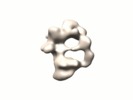

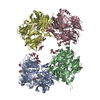
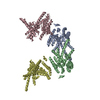

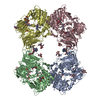
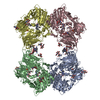

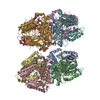
 Z (Sec.)
Z (Sec.) Y (Row.)
Y (Row.) X (Col.)
X (Col.)





















